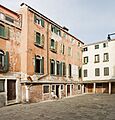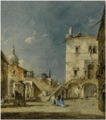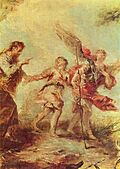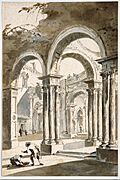Francesco Guardi facts for kids
Quick facts for kids
Francesco Guardi
|
|
|---|---|
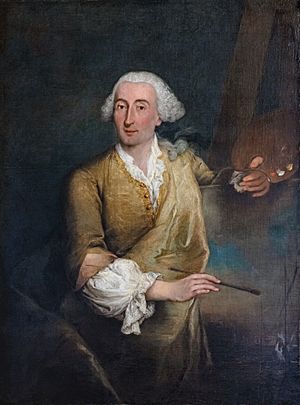
Francesco Guardi portrayed by Pietro Longhi (1764)
|
|
| Born | 5 October 1712 Venice, Republic of Venice (now Italy)
|
| Died | 1 January 1793 (aged 80) Venice, Republic of Venice
|
| Nationality | Venetian |
| Known for | Painting |
| Movement | Venetian School |
Francesco Lazzaro Guardi (born October 5, 1712 – died January 1, 1793) was an Italian painter. He was a nobleman and part of the Venetian School of painting. He is known as one of the last great artists of this classic style, along with his brothers.
Early in his career, Francesco worked with his older brother, Gian Antonio. They mostly painted religious scenes together. After Gian Antonio died in 1760, Francesco started focusing on vedute. These are paintings of city views or landscapes.
At first, his city views looked a bit like those by another famous painter, Canaletto. But Francesco soon developed his own style. He used quick, lively brushstrokes and often imagined buildings in his paintings.
Contents
Francesco Guardi: A Venetian Painter
Francesco Guardi was born in Venice, Italy. His family was from a noble background in Trentino. His father, Domenico, and his brothers, Niccolò and Gian Antonio, were also painters. When his father died in 1716, the brothers took over the family art workshop. They likely worked together on many big painting projects.
Francesco's sister, Maria Cecilia, married Giovanni Battista Tiepolo. He was a very important painter in Venice at that time.
Early Career and First Works
In 1735, Guardi started working in the studio of Michele Marieschi. He stayed there until 1743. His first known paintings are from 1738. They were for a church in Vigo d'Anuania, in Trentino. During this time, he worked closely with his older brother, Gian Antonio.
Francesco's first painting that he signed himself was Saint Adoring the Eucharist, painted around 1739. In these early years, he painted both landscapes and scenes with people. His early city views were influenced by Canaletto and Luca Carlevarijs.
On February 15, 1757, Francesco married Maria Mattea Pagani. She was the daughter of another painter, Matteo Pagani. In 1760, his brother Gian Antonio died. That same year, Francesco's first son, Vincenzo, was born. His second son, Giacomo, was born in 1764.
Later Works and Recognition
In 1763, Francesco worked in Murano, an island near Venice. He painted Miracle of a Dominican Saint for the church of San Pietro Martire. This painting showed the clear influence of Alessandro Magnasco's expressive style.
One of Francesco Guardi's most important later works is the Doge's Feasts. This was a series of twelve paintings. They showed the grand ceremonies held in 1763 when Alvise IV Mocenigo was chosen as the new Doge (the leader of Venice). As he got older, Canaletto's influence on Guardi's art became less noticeable. You can see this in his painting of the Piazzetta in the Ca' d'Oro in Venice. Around 1778, he painted Holy Trinity Appearing to Sts. Peter and Paul for a church in Roncegno.
In 1782, the Venetian government asked Guardi to paint six canvases. These were to celebrate the visit of the Russian Grand Dukes to Venice. Only two of these paintings still exist today. He also painted two others for the visit of Pope Pius VI. On September 12 of that year, he became a member of the Fine Art Academy of Venice.
His later paintings, like the Concerto of 80 Orphans (1782) in Munich, show a stronger focus on colors. Another example is the Façade of Palace with Staircase in the Accademia Carrara of Bergamo.
Francesco Guardi died in Venice in 1793.
Guardi's Unique Painting Style
Many paintings are believed to be by either Francesco or his brother Gian Antonio Guardi. One of the most admired works is not a landscape. It is the light and hazy Story of Tobit. This painting was made for the organ loft in the small Chiesa dell'Angelo San Raffaele church.
Guardi's painting style is called pittura di tocco. This means "painting of touch." It refers to his use of small dots and lively brushstrokes. This looser style was also used by other painters like Giovanni Piazzetta and Sebastiano Ricci. It reminded some people of the soft, hazy style of Barocci. This style was very different from the more detailed and accurate architectural style of Canaletto's paintings. A century later, this unique style made Guardi's works very popular with the French Impressionists.
Comparing Guardi and Canaletto
Canaletto was a vedutista, meaning he painted city views. He often focused on the grand buildings and architecture of Venice. He showed Venice in bright, sunny daylight, with many clear and detailed lines.
On the other hand, Guardi's paintings often show buildings that seem to blend into a hazy, almost melting lagoon. He often painted cloudy skies and cities at dusk. While Canaletto showed the everyday life and neighborhoods, Guardi's paintings sometimes showed the grand ceremonies of Venice. However, Guardi's art often captured a feeling of decline. The people in his paintings sometimes look small, like a crowd watching something they can't change. An example is his Fire in the Oil Depot in San Marcuola. This style seemed to fit the feeling of Venice's power slowly fading away.
Images for kids
Gallery
-
View on the Grand Canal at San Geremia, Venice (1760–1765), Frick Collection
-
Regatta in Venice (1770), Frick Collection
-
Procession of Gondolas in the Bacino di San Marco (c. 1782), Museum of Fine Arts, Boston
-
Lagoon Looking Towards Murano from the Fondamenta Nuova (1765-1770), Fitzwilliam Museum
-
A Colonnade, Partly Ruined, with Figures (1780 – 90), Metropolitan Museum of Art
See also
 In Spanish: Francesco Guardi para niños
In Spanish: Francesco Guardi para niños


